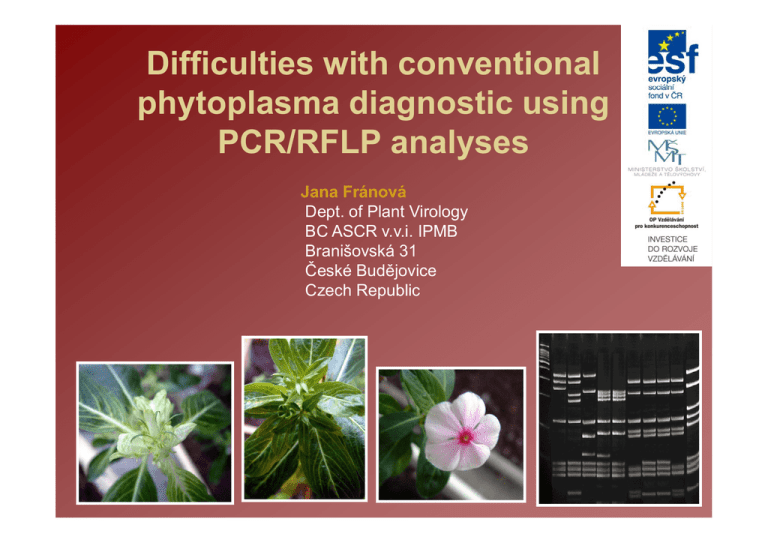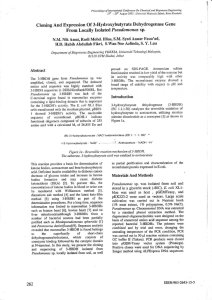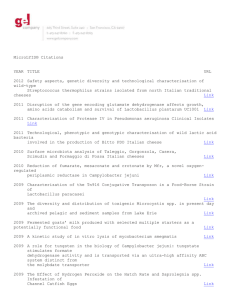Difficulties with conventional phytoplasma diagnostic using PCR
advertisement

Difficulties with conventional phytoplasma diagnostic using PCR/RFLP analyses Jana Fránová Dept of Plant Virology Dept. BC ASCR v.v.i. IPMB Branišovská 31 České Budějovice Czech Republic PCR difficulties: Nonspecific reactions: – contamination (use powder free gloves gloves, pipets with filter, sterile tips with filter, close the windows) – from phytoplasma positive samples M Ep Ep W W W W – from phytoplasma positive controls – and/or with other micro-organisms – amplification of plant DNA – some primers i can iinduce d di dimers, b band d off nonspecific ifi sizes (Heinrich et al., 2001) F1/R0→F1(III)/R2(III) f l positives false iti inclusion of negative controls is necessary (DNA isolated from corresponding healthy plants, sterile water, amplification without template) M AP CP AY W W W W W W AP CP AY W W W W P1/P7 F1/B6 M AP CP AY W W W W W AP CP AY W W W W W P1/P7F1/B6 F2/R2 false negatives – check DNA quality and quantity (20ng/reaction, use higher dilution of DNA) – use more sensitive PCR method (nested PCR PCR, second nested PCR, group specific primers) – include positive control (different from those, which are expected to be present in examined samples) M 1 2 3 4 5 6 7 8 9 10 11 12 13 14 15 16 M 17 18 PK W W W W P1/P7 P1/P7 M 1 2 3 4 5 6 7 8 9 10 11 12 13 14 15 16 P1/P7F1/B6 F2/R2 M 17 18 PK W W W P1/P7F1/B6 F2/R2 false negatives or week positives, smears – use primers from different company – change Taq polymerase or PCR Mix M M 1 2 3 1 2 1 2 3 4 5 6 7 W 3 PCR Mix of firm III P1/P7→P1A/P7A→F2n/R2 fi I firm firm fi II M 1 2 3 4 P1/P7 PCR Mix of firm IV 5 6 7 W PCR difficulties – different PCR Mix – different primer combination M 1 2 3 4 5 6 7 8 9 10 11 12 13 14 15 16 M PCR Mix of firm III M 1 2 3 P1/P7F1/B6 F2/R2 4 5 6 7 8 W P1A/P7A→F1/B6→F2/R2 PCR Mix of firm IV 17 18 19 20 CP AY AP W W P1/P7F1/B6 F2/R2 PCR Mix of firm III PCR difficulties – change Taq polymerase or PCR Mix – different primer combination M 1 2 3 4 5 6 7 8 9 10 11 12 13 14 15 16 P1/P7 F2/R2 PCR Mix of firm III M 1 1 2 2 3 3 3 W 1 1 1 2 2 2 W – repeat and/or optimize PCR ((hot start,, gradient g PCR) – try direct PCR P 399/P 1694 Pc399/Pc1694 PCR Mix of firm IV rpAP15f/rpAP15r false positives confirmation of phytoplasma presence by RFLP (at least with 2 or more endonucleases) is necessary and/or using other primer i combination bi ti RFLP difficulties - unusual or illegible profiles → repeat and/or optimize PCR - secondary bands → optimization of digestion (time elongation) M I-B I-C II-A III-A X-A d i g e s t t. 20 hours AluI X-B XII-A P1/P7→F2/R2 M I-B I-C II-A III-A X-A X-B XII-A AluI P1/P7→P1A/P7A→F2/R2 d i g e s t. 60 hours DNA digestion with more enzymes for phytoplasma identification M I-B I-C II-A III-A X-A X-B XII-A HhaI M M I-B I-C II-A III-A X-A RsaI X-B II-B B II-C C II II-A A III III-A A XII-A MseI X X-A A X X-B B XII XII-A A Evaluation of different primers DNA iisolation l ti ( h (phenol/chloroform) l/ hl f ) ffrom • phytoplasma reference strains (PnWB, CX, GSFY/1, GSFY/2,, MOL,, AY,, CPh,, CYE,, AP,, PD)) • 18 healthy Catharanthus roseus plants PCR PCR: P1/P7→ P1A/P P1/P P1A/P71 1 → F1/B6 → F2n/R2 → fU5/rU3 → fU5/P7 → fU2/P7 → 16R 758F/16R1232R → R16F1/R0 → Pc399/Pc1694 → R16 F1(I)/R1(I) P1A/P7A →F1/B6 → F2n/R2 •PCR: P1/P7→ P1A/P71 → F2n/R2 P1/P7 → F1/B6 → F2n/R2 P1/P7 → F1/B6 → 16R758F/16R1232R P1/P7 → F1/B6 → fU5/rU3 P1/P7→ F2n/R2 → R16 F1(I)/R1(I) •RFLP: RFLP: AluI, AluI HhaI, HhaI MseI, MseI RsaI (R16F2n/R2 amplicons) •DNA sequencing (1 healthy looking C. plant), ), comparison p with data roseus p available in the GenBank (BLAST) Results: M I-B I-C II-A III-A X-A Specific amplification: P1/P7→ P1A/P7A → F1/B6 → F1/R0 M AY CP PnwB CX AP GSFY S → R16F2n/R2 U5/ → fU5/P7 P1/P7→ F1/B6 → R16F2n/R2 P1/P7→ P1A/P7A → R16F2n/R2 P1A/P7A → R16F2n/R2 P1/P7→F2n/R2 M 1 2 3 4 5 6 7 8 PC P1/P7→F2n/R2 X-B XII-A MseI -specific amplification of DNA from positive controls including RFLP confirmation of phytoplasmas identity - usually no product with DNA from 18 C. roseus plants and water controls Results: Lower specificity, contamination or nonspecific amplification: P1/P7→ F1(I)/R1(I) → fU5/rU3 → 16R758F/16R1232R (M1/M2) - DNA iisolated l t d ffrom 5 h healthy lth C. C roseus plants l t gave positive iti results in PCR with some primer combinations (in our hands) M 1 2 M 1 2 3 4 5 6 7 8 3 4 NC PC 9 10 11 12 13 NC PC P1/P7→R16F2n/R2 M 1 2 3 4 5 NC NC NC PC P1/P7→fU5/rU3 P1/P7→M1/M2 Results: RFLP of F2/R2 amplicons after digestion with MseI and AluI obtained from healthy C. roseus M 9 14 18 NC PC M I-B I-C II-A III-A X-A X-B XII-A MseI MseI Positive controls DNA sequencing (sample no. 9) exclude phytoplasma presence M 3 6 9 14 AluI Conclusion: • In the case of phytoplasma positive samples, primers p preferentially y amplified p p phytoplasma y p the p sequence of expected sizes, exceptionally, additional bands could be observed • In the case of DNA isolated from healthyy p plants, some primers can react probably with sequences of plant genome or dimers and false positives could be observed b d Including DNA from corresponding healthy plant and water controls is necessary Conclusion: •PCR PCR alone is not sufficient enough for phytoplasma detection. Confirmation of phytoplasma presence and its identification must be accomplished at least by RFLP, using two or more endonucleases •Critical samples: different primer pair combination, RFLP with more enzymes and sequencing should be used for elucidation of phytoplasma p y p p presence Děkuji za pozornost

